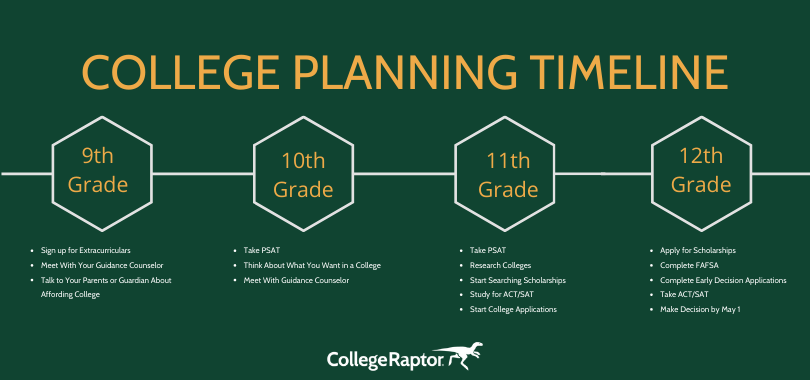Did you know that your college planning timeline should start in your freshman year of high school, if not earlier? You might really want to put it off, but it’s not something that can wait until your senior year! You’ll be like a chicken with its head cut off if you wait too long. This college preparation timeline will help you get everything done without last minute stress or help you catch up if you’re a little behind.
9th Grade – Fall
Sign up for Extracurriculars
This is the perfect time to start looking into clubs, sports, volunteer opportunities, and extracurriculars that interest you. If you’re not sure what options are available to you, talk to teachers that teach subjects that are up your alley or meet with your guidance counselor.
Colleges are looking for students who do more than just earn good grades, so this is a must!

9th Grade – Spring
Meet With Your Guidance Counselor
Towards the end of 9th grade, you should have a meeting with your guidance counselor. You should discuss your overall plans for high school, your schedule for 10th grade, and any ideas you have about college already. They may have suggestions for electives based on your passions and goals. Really, your college planning timeline starts here!
Talk to Your Parents or Guardian About Affording College
College can be expensive. It’s important to have a plan well ahead of time for affording the cost. It’s possible your parents or guardian put together a 529 plan for you. You might also be required to take out loans. Starting this conversation early will help you fully plan for the upcoming costs.
Print Your Freshman Year Checklist.
10th Grade – Fall
October: Take the PSAT
If your school offers it, the first PSAT will become available to you during your sophomore year! You should view this as a practice exam, but that doesn’t mean you shouldn’t study. Knowing what to expect can pay off big time in the years to come.
10th Grade – Spring
Think About What You Want in a College
As you enter the second half of 10th grade, it’s important to be going over what you want in a college. Even if these are just notes in the margin of your notebook, it’s a good start. Consider where you’d like to attend (far away vs close), the type of setting you’d enjoy (city vs village), and majors that sound interesting to you. Write down anything that comes to mind from career options to clubs you’d like to join. This will all come in handy!
Meet With Your Guidance Counselor
As 10th grade comes to a close, you’ll have to meet with your guidance counselor to go over your 11th grade schedule. This is the perfect time to ask about AP and college classes that your school may offer. You might also want to bring up what you’ve been thinking about for college, too.
Print Your Full Sophomore Year College Prep Checklist.
11th Grade – Fall
October: Take the PSAT
The PSAT comes available again to juniors in October. This one does matter! If you score well enough, you could be named a National Merit Scholar and win a scholarship. Studying now will also help you when it’s time to take the SAT or ACT.
Research Colleges
With your list of wants, needs, and interests in hand, it’s time to search for colleges. Using College Match tools can help you uncover the best schools that fit you and your accomplishments. This list of schools that interest you can be long to begin with, but you will have to narrow it down soon. This is also a perfect opportunity to attend college fairs!
11th Grade – Spring
Start Your Scholarship Search
There are plenty of scholarships out there available to students – you just need to look for them! Scholarship databases can help you uncover the awards you qualify for, track your applications, and notify you of new ones that become available. Make sure to check out the requirements before you apply so you don’t waste time, and note any deadlines for upcoming scholarships.
Study for the SAT and ACT
Now that you have both PSATs under your belt, it’s time to study for the real deals. From flashcards to practice tests to phone apps, there are plenty of options to help you tackle the SAT or ACT. You should also think about which you’re going to take! Tip: play to your strengths.
Meet With Your Guidance Counselor
And, of course, it’s time for the annual meeting with your guidance counselor. You should be having conversations about signing up for AP or college classes, your PSAT results, your plans for senior year, and your thoughts about college. This is the perfect time to talk about any reservations or worries you have and to ask questions.
11th Grade – Summer
Narrow Down Your College List
During the summer you need to be narrowing down your college list. This means crossing out schools that you either don’t qualify for or colleges that really don’t fit your wants and needs. Take note of admission requirements and decide whether a school is a stretch, a safety, or somewhere in between. You should apply to two to fifteen colleges.
Visit College Campuses
If you can, summer is the perfect opportunity to be visiting college campuses. Start with the schools that interest you the most. Remember: online and in-person tours only show you what the college wants you to see. You need to do a bit of research to get a real idea of the school. Consider talking to current students, too.
If you can’t afford to visit campuses, especially ones that are far away, you might want to wait until after you have acceptance letters in hand to visit.
Start College Applications
While you don’t have to submit your college applications anytime soon, you should at least be taking a look at them. Note deadlines, materials required, essay topics, and other necessary information you’ll need to complete the paperwork. You should also be thinking about early action vs early decision vs regular decision. This decision will affect your college application due date.
If you have any questions about the application, processes, or anything else related to the school, be sure to reach out to college representatives to get the answers!
Take the ACT or SAT
Your first ACT or SAT, if you haven’t taken one yet, should happen this summer. It’s generally recommended you take at least two tests, if not more. Once you’ve completed the exam and get your results back, review your scores. This will help you on the second go-around.
Print Your Full Junior Year College Prep Checklist.
12th Grade – Fall
Meet With Your Guidance Counselor
During your senior year of high school, you shouldn’t wait until an annual meeting to meet with your guidance counselor. Instead, you should be setting up regular meetings with them to review your college goals, applications, and more. College counseling can provide direction during this busy year!
Apply to Scholarships
This really is for your entire senior year (and all of college), but you need to start applying to those awards you qualify for. Even if you think you don’t have a chance or the amount isn’t a lot, still apply! You never know and those smaller amounts do add up.
Complete the Free Application for Federal Student Aid
The Free Application for Federal Student Aid (FAFSA) becomes available on October 1st. You should take time before gathering all the necessary financial documents from your parents. While you don’t have to complete it on the 1st, it is highly recommended that you submit your application as soon as possible. Money from schools and the government will be gone if you wait too long!
Take the ACT or SAT
During the fall, you need to be taking at least your second ACT or SAT test. If you’re planning on taking more than one this semester, be sure to schedule some earlier in the season and some later. Don’t wait until winter to take them – too late and the schools will not see the later grades as part of your application.
Ask for Letters of Recommendation
Most college applications require letters of recommendation. We highly recommend asking for them as soon as possible. Teachers are often busy and others are asking them for letters, too. Requesting them sooner rather than later will help ensure you’re not scrambling for a replacement as the application due date arrives.
Complete Early Action or Early Decision I Applications
Early Action and Early Decision applications are usually due on November 1st or 15th. You will need to have your ducks in a row as soon as possible if you’re planning on applying under these.
12th Grade – Winter
If You Applied Under Early Action or Early Decision I, Wait for Your Letters!
Most Early Action or Early Decision I letters will arrive by mid-December. If you applied under Early Decision and were accepted, you will need to submit your deposit as it is a binding agreement. Early Action students can wait until May to make their decision.
Complete Your Regular Decision or Early Decision II Applications
Regular decision and Early Decision II applications are usually due on January 1st (schools can vary, so be sure to check so you don’t miss an important deadline!). We recommend completing them at least a week or two ahead of time so if you run into any technical issues, they can be solved.
Use a checklist during December to ensure you have everything you need when you go to submit. Missing something could result in a rejection letter!
12th Grade – Spring
Wait For Acceptance Letters
Early Decision II acceptance and rejection letters will come by mid-February. As with Early Decision I, this is a binding agreement and you will need to submit your deposit if you’re accepted.
Regular decision letters should come in March or early April. We recommend waiting for all your letters or emails to arrive before making a decision.
Review Financial Aid Packages
It’s likely that financial aid packages and offers will come with your acceptance letters. This can be complex and confusing, so it’s important to understand how to compare them to be sure you’re making a sound financial decision. You can also reach out to the financial aid office with any concerns or questions.
Don’t Catch Senioritis
Even if you have some acceptance letters from schools – even if it’s from your dream college – don’t slack off during your senior year. Colleges have and will rescind offers if they notice a student’s grades plunged in the final months.
Make Your Decision by May 1st
Unless you applied under Early Decision I or II, you will likely have to make your college choice by May 1st. You should also notify the schools you were accepted to but have not decided to attend.
Celebrate!
You’ve done it! You completed four years, graduated high school, and are going to college in the fall. Now is the time to celebrate your accomplishments and treat yourself.
Print Your Senior Year College Planning and Prep Checklist.
You will have a few other things to complete in the coming months, mostly related to registration for your new college. But there’s no better time than now to look back on all you’ve done of your high school experience and look forward to the future.
No matter where you are in your college planning experience, College Raptor has the tools you need to make the process less stressful and less challenging. Take advantage of our College Match tool to uncover the best schools for your wants and needs, use our Financial Aid Offer Comparison tool to cut through the complexity of your offers, and discover awards you qualify for with our Scholarship Search.





